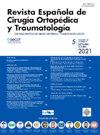全髋关节置换术并发症的风险因素。
Q3 Medicine
Revista Espanola de Cirugia Ortopedica y Traumatologia
Pub Date : 2025-05-01
DOI:10.1016/j.recot.2024.06.006
引用次数: 0
摘要
简介和目的:髋关节置换术在治疗难治性慢性关节疼痛方面取得了重大进展,改善了患者的生活质量和功能。本研究旨在确定与全髋关节置换术患者局部和全身并发症相关的风险因素:观察、分析、回顾性队列研究,包括 304 名接受全髋关节置换术的患者。结果:并发症组患者的平均年龄为18岁,无并发症组患者的平均年龄为18岁:并发症组的平均年龄为 66 岁(标准差 18.7),无并发症组的平均年龄为 67.1 岁(标准差 15.1)(P 0.686)。有并发症组中女性占 73.3%,无并发症组中女性占 65%(P 0.292)。(p 0.292).风险因素包括:髋部骨折是关节置换术的适应症 RR 1.33 [ 95% CI 1.004;1.775 p 0.047],冠心病 RR 1.31 [95% CI 1.067;1.616 p 0.010],手术出血量大于等于 400 cc RR 1.11 [95% CI 1.012;1.218 p 0.028]:全髋关节置换术并发症的风险因素包括:髋部骨折是关节置换术的适应症、冠状动脉疾病以及手术出血量大于等于400毫升。本文章由计算机程序翻译,如有差异,请以英文原文为准。
Factores de riesgo para complicaciones en artroplastia total de cadera
Introduction and objective
Hip arthroplasty represents a significant advancement in the treatment of refractory chronic joint pain, improving quality of life and functionality. The objective of this study is to identify the risk factors associated with local and systemic complications in patients treated with total hip arthroplasty.
Methods
Observational, analytical, retrospective cohort study, which included 304 participants treated with total hip replacement. Comparison of variables between two groups was performed; 38 participants in the group with complications and 266 participants in the group without complications.
Results
The mean age in the complication group was 66 years (SD 18.7) and in the uncomplicated group it was 67,1 years (SD 15.1) (p 0,686). Female sex was observed in 73.3% of the group with complications and 65% in the group without complications. (p 0.292). Risk factors were: hip fracture as an indication for arthroplasty RR 1.33 [95% CI 1.004;1.775 p 0.047], coronary heart disease RR 1.31 [95% CI 1.067;1.616 p 0.010] and surgical bleeding equal to or greater than 400 cc RR 1.11 [95% CI 1.012;1.218 p 0.028].
Conclusions
The risk factors for complications in total hip arthroplasty were: hip fracture as the indication for arthroplasty, coronary artery disease, and surgical bleeding equal to or greater than 400 cc.
求助全文
通过发布文献求助,成功后即可免费获取论文全文。
去求助
来源期刊

Revista Espanola de Cirugia Ortopedica y Traumatologia
Medicine-Surgery
CiteScore
1.10
自引率
0.00%
发文量
156
审稿时长
51 weeks
期刊介绍:
Es una magnífica revista para acceder a los mejores artículos de investigación en la especialidad y los casos clínicos de mayor interés. Además, es la Publicación Oficial de la Sociedad, y está incluida en prestigiosos índices de referencia en medicina.
 求助内容:
求助内容: 应助结果提醒方式:
应助结果提醒方式:


